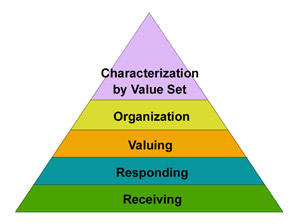Krathwohl's Taxnomy of Affective Domain
Krathwohl's affective domain taxonomy is perhaps the best known of any of the affective taxonomies. "The taxonomy is ordered according to the principle of internalization. Internalization refers to the process whereby a person's affect toward an object passes from a general awareness level to a point where the affect is 'internalized' and consistently guides or controls the person's behavior (Seels & Glasgow, 1990, p. 28)."
 Receiving is being aware of or sensitive
to the existence of certain ideas, material, or phenomena and being willing
to tolerate them. Examples include: to differentiate, to accept, to listen
(for), to respond to.
Receiving is being aware of or sensitive
to the existence of certain ideas, material, or phenomena and being willing
to tolerate them. Examples include: to differentiate, to accept, to listen
(for), to respond to.
Responding is committed in some small measure to the ideas, materials, or phenomena involved by actively responding to them. Examples are: to comply with, to follow, to commend, to volunteer, to spend leisure time in, to acclaim.
Valuing is willing to be perceived by others as valuing certain ideas, materials, or phenomena. Examples include: to increase measured proficiency in, to relinquish, to subsidize, to support, to debate.
Organization is to relate the value to those already held and bring it into a harmonious and internally consistent philosophy. Examples are: to discuss, to theorize, to formulate, to balance, to examine.
Characterization by value or value set is to act consistently in accordance with the values he or she has internalized. Examples include: to revise, to require, to be rated high in the value, to avoid, to resist, to manage, to resolve.
Krathwohl, D.R., Bloom, B.S., and Masia, B.B. (1964). Taxonomy of educational objectives: Handbook II: Affective domain. New York: David McKay Co.
Seels and Glasgow (1990). Exercises in instructional design. Columbus OH: Merrill Publishing Company.
Task Analysis